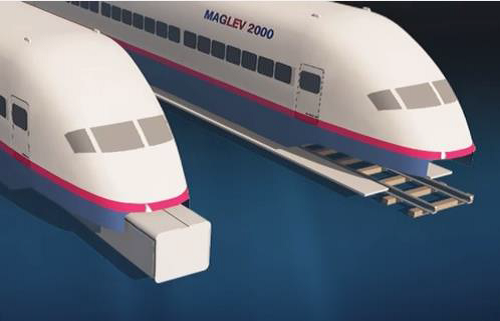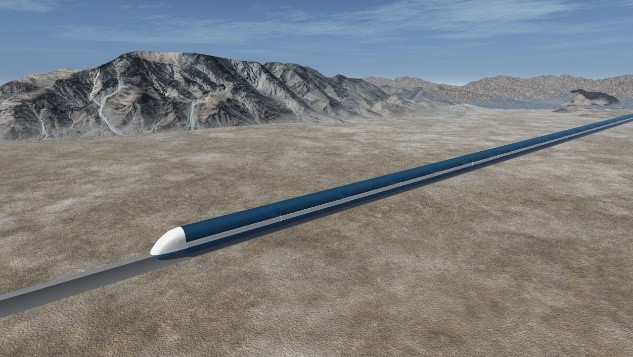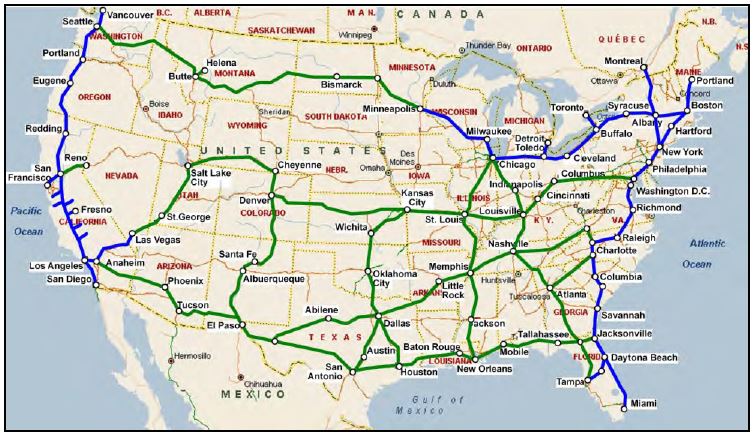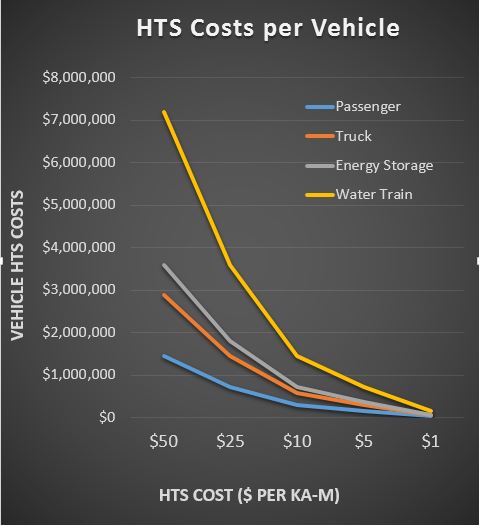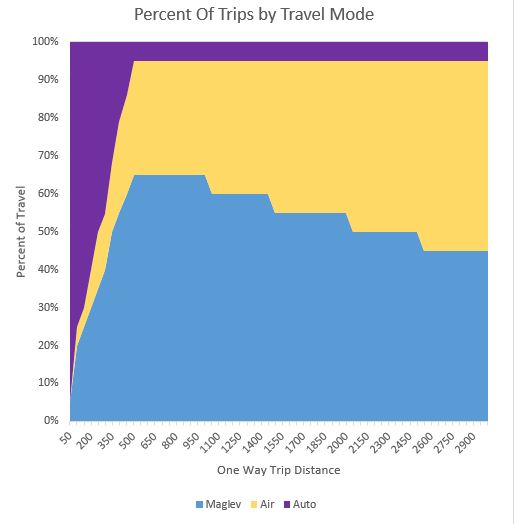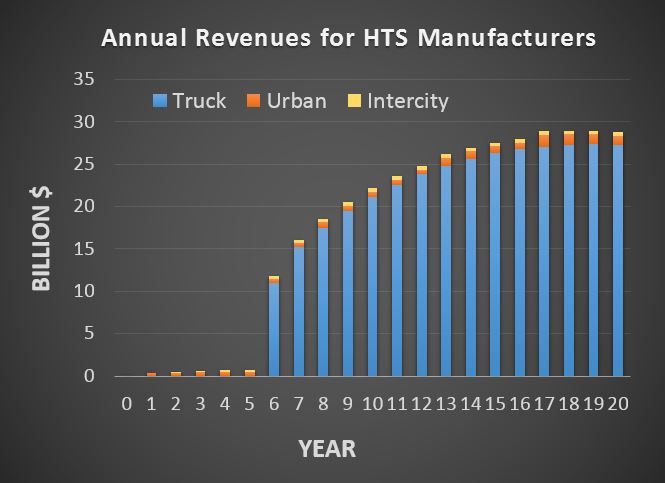Maglev transportation technologies represent vast new markets for High Temperature Superconductors (HTS) since each vehicle requires many kilometers of HTS wire.
The Danby-Powell 2nd Generation Maglev system will create more demand for HTS products than any other maglev technology. This is because the M2000 system is designed to address more than just intercity passenger transportation. The M2000 system is also ideal for urban transit, heavy freight transport, grid-scale energy storage, and long distance water transportation. Because the M2000 design addresses all these very large, global markets, we project that the demand for HTS wire will reach into the hundreds of billions of dollars within 20 years.
This page briefly describes each of the M2000 applications, at what HTS price they become competitive, and finally presents some preliminary market forecasts for HTS demand in the intercity, urban, and freight transport markets in the USA.
High Speed Intercity Passenger Transportation
This is the traditional application that most people think of when they hear the word “Maglev”. Compared with steel wheel high-speed rail, maglev provides higher speeds (350 mph vs 200 mph) with lower capital costs and much lower operations and maintenance costs. High speed rail systems are notoriously expensive and often require significant government subsidies to remain solvent. In the United States, high speed rail systems that transport passengers only will be even more unprofitable. Luckily the M2000 system has a solution, the capital costs and operating expenses are paid for by the revenues generated from carrying freight on the same fixed infrastructure. Unlike other maglev designs or high speed rail systems, the M2000 system can carry both passenger and freight vehicles on the guideways.
- HTS required per passenger vehicle: 28,000 kA-m
Truck and Freight Transportation
Trucking is now a $700B business in the United States, larger than all other transportation businesses combined. Longhaul trucks travel an average distance of 500 miles per trip charging an average of $0.30 per ton mile. About 2/3 of trucking operating costs are solely for fuel and labor. Thus, trucking companies could see enormous increases in profitability if they could reduce fuel costs and labor hours substantially by transporting longhaul trucks on roll-on/roll-off maglev vehicles. Capturing just a fraction of the longhaul trucking business would pay for the capital costs of maglev infrastructure construction.
- HTS required per freight vehicle: 57,600 kA-m
.
.
.
Urban Passenger Transportation
The same M2000 design used in high speed intercity passenger transportation can be used in urban settings as well. Because M2000 vehicles can operate on both high speed beam-style guideways and low speed planar-style guideways, an M2000 vehicle can run on existing rail infrastructure that has been modified to allow simultaneous rail and maglev operations. This is called the MERRI system: Maglev Emplacement on RailRoad Infrastructure. Such flexibility allows local transit agencies to transition the existing commuter systems, gradually, to an all maglev design.
- HTS required per passenger vehicle: 28,000 kA-m
Maglev Energy Storage
M2000 technology can be used to store gigawatt-hours of energy to level loads on an overburdened electricity grid. Similar in concept to pumped hydro storage, M2000 vehicles transport mass (i.e. concrete blocks) uphill to a storage yard when electricity demand is low and prices are cheap, and then when demand peaks and electricity prices are high, those same blocks are transported back downhill to generate electricity which can be fed into the grid and sold for profit. Unlike pumped hydro, maglev energy storage can be sited at many, many locations throughout the world, with minimal environmental impact.
- HTS required per energy storage vehicle: 72,000 kA-m
Water Train
Though it may seem counterintuitive, there are many situations where it is cheaper to transport water long distances by maglev than by pipeline, especially when significant elevation changes are involved. With pipelines, extensive pumping infrastructure is needed to overcome elevation, and specialized pipes need to be constructed to withstand the pressure changes associated with elevation changes. With M2000 technology, no pumping infrastructure is required, and maglev can more efficiently recapture energy expended when moving uphill when the vehicle travels back downhill again.
- HTS required per energy storage vehicle: 144,000 kA-m
Preliminary HTS Market Estimate for a US National Maglev Network for Intercity Passengers, Freight and Connections to Urban Maglev Systems
What follows are some rough estimates of the HTS market size if the USA were to develop a national maglev network. As one can see, the total market size would range in the hundreds of billions of dollars annually. Furthermore, this analysis does not include HTS demand from either Maglev Energy Storage, or from Water Train, both of which may become large markets for HTS in the future. Also, this analysis in for the US only.
Assumptions:
- 29,000 miles of maglev guideway in network
- 32 Urban Areas – added exponentially during 20 year period (i.e later years see greatest growth)
- 20 year building period in 4 phases:
- Phase 1 – 5 Year test and development program
- Phase 2 – 5 Year 6200 miles new maglev network
- Phase 3 – 5 Year addition to 18,600 total miles
- Phase 4 – 5 Year addition to total 29,000 total miles
- HTS price needed for national network viability ~ $50 per kA-meter
- Assumed price drop in HTS similar to solar – 8% per year
- $900B total system cost can be self-funding by capturing a fraction of the US Trucking Freight Revenue.
- Total Vehicles in System at Year 20:
- Intercity Passenger Vehicles: 13,886
- Urban Transit Vehicles: 32,000
- Trucking Carrying Freight Vehicles: 400,000
The completed US National Maglev Network in 2035:
HTS costs drive maglev vehicle costs and maglev adoption:
Maglev will become a dominant form of transportation in the 21st century:
The total market size for HTS in the US alone is staggering.

